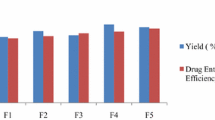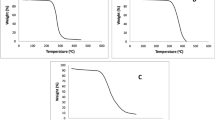Abstract
The present study was undertaken to develop and evaluate an oro-dispersible, sustained release tablet of metoclopramide HCl. The technology was comprised of developing sustained release microparticles, and compression of resultant microspheres into a fast dispersible tablet by direct compression. The microspheres of metoclopramide HCl were prepared by an emulsification-solvent evaporation method using ethylcellulose as the matrix polymer. The prepared microspheres were evaluated for morphology, particle size, entrapment efficiency, and in vitro drug release characteristics. Scanning electron microscopy demonstrated spherical particles with a mean diameter of 81.27 ± 5.87 μm and the drug encapsulation efficiency was found to be 70.15 ± 3.06%. The process and formulation variables such as rotation speed, polymer concentration, and drug concentration influenced the drug encapsulation efficiency and in vitro drug release. Optimized microspheres were compressed into tablets which were comprised of metoclopramide HCl microspheres, 53% (w/v) of D-mannitol granules, 7% (w/w) of Polyplasdone XL 10, and 0.5% (w/w) of calcium stearate. The tablets demonstrated a hardness of 59 ± 3 N, friability of 0.21% and disintegration time of 27 ± 3 sec. The formulations were subjected to stability studies as per ICH guidelines and were found to be stable after a 6 month study. In vivo experiments conducted in rats demonstrated that a constant level of metoclopramide HCl in plasma could be maintained for up to 20 h at a suitable concentration for antiemetic activity. An appropriate combination of excipients made it possible to obtain orally disintegrating sustained release tablets of metoclopramide HCl using simple and conventional techniques.
Similar content being viewed by others
References
Benita, S., Microencapsulation: Methods and Industrial applications. 2nd ed. Marcel Dekkar, New York, NY, pp. 183–211, (1996).
Bi, Y., Sunada, H., Yonezawa, Y., Danjo, K., Otsuka, A., and Iida, K., Preparation and evaluation of a compressed tablet rapidly disintegrating in oral cavity. Chem. Pharm. Bull. (Tokyo), 44, 2121–2127 (1996).
Chang, R., Guo, X., Burnside, B., and Couch, R., Fast-dissolving tablets. Pharm. Tech., 24, 52–58 (2000).
Costa, P. and Sousa Lobo, J. M., Modeling and comparison of dissolution profiles. Eur. J. Pharm. Sci., 13, 123–133 (2001).
Das, M. K. and Rao, K. R., Evaluation of zidovudine encapsulated ethylcellulose microspheres prepared by water-inoil-in-oil (w/o/o) double emulsion solvent diffusion technique. Acta Pol. Pharm., 63, 141–148 (2006).
Dixit, R. P. and Puthli, S. P., Oral strip technology: overview and future potential. J. Control. Release, 139, 94–107 (2009).
El-Sayed, Y. M., Niazy, E. M., and Khidr, S. H., In vivo evaluation of sustained-release microspheres of metoclopramide hydrochloride in beagle dogs. Int. J. Pharm., 123, 113–118 (1995).
Fukushima, M., Inaba, Y., Kobari, S., and Morishita, M., Process for manufacturing microcapsules. U.S. Patent 3,891,570 (1975).
Habib, W., Khankari, R., and Hontz, J., Fast-dissolve drug delivery systems. Crit. Rev. Ther. Drug Carrier Syst., 17, 61–72 (2000).
Kanig, J. L. and Rudnic, E. M., The mechanisms of disintegrant action. Pharm. Tech., 8, 50–62 (1984).
Lindgren, S. and Janzon, L., Dysphagia: prevalence of swallowing complaints and clinical finding. Med. Clin. North Am., 77, 3–5 (1993).
McGinity, J. W. and O’Donnell, P. B., Preparation of microspheres by the solvent evaporation technique. Adv. Drug Deliv. Rev., 28, 25–42 (1997).
Morita, Y., Tsushima, Y., Yasui, M., Termoz, R., Ajioka, J., and Takayama, K., Evaluation of the disintegration time of rapidly disintegrating tablets via a novel method utilizing a CCD camera. Chem. Pharm. Bull. (Tokyo), 50, 1181–1186 (2002).
Reynolds, J. E. F., MartinDale: The Extra Pharmacopoeia, 30th ed. Royal Society of Great Britain. The Pharmaceutical Press, London, pp. 142–145, (2006).
Sastry, S. V., Nyshadham, J. R., and Fix, J. A., Recent technological advances in oral drug delivery — a review. Pharm. Sci. Technol. Today, 3, 138–145 (2000).
Tripathi, K. D., Essentials of medical pharmacology, 4th ed. Jaypee Brothers Medical Publisher, New Delhi, pp. 649–650, (2001).
Wade, A. and Weller, P. J., A Handbook of Pharmaceutical Excipients, 2nd ed. American Pharmaceutical Association and Pharmaceutical Press, Washington DC and London, pp. 1177–1185, (1994).
Author information
Authors and Affiliations
Corresponding author
Rights and permissions
About this article
Cite this article
Kasliwal, N., Negi, J.S., Jugran, V. et al. Formulation, development, and performance evaluation of metoclopramide HCl oro-dispersible sustained release tablet. Arch. Pharm. Res. 34, 1691–1700 (2011). https://doi.org/10.1007/s12272-011-1013-3
Received:
Revised:
Accepted:
Published:
Issue Date:
DOI: https://doi.org/10.1007/s12272-011-1013-3




